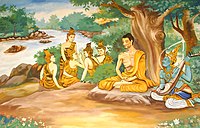


Many smaller clans mentioned within early literature seem to have been present across the rest of the subcontinent. Some of these kings were hereditary; other states elected their rulers. The educated speech at that time was Sanskrit, while the dialects of the general population of northern India are referred to as Prakrits. Many of the sixteen kingdoms had coalesced to four major ones by 500/400 BCE, by the time of Siddhartha Gautama. These four were Vatsa, Avanti, Kosala and Magadha.[25]
Hindu rituals at that time were complicated and conducted by the priestly class. It is thought that the Upanishads, late Vedic texts dealing mainly with incipient philosophy, were composed in the later Vedic Age and early in this period of the Mahajanapadas (from about 600 - 400 BCE). Upanishads had a substantial effect on Indian philosophy, and were contemporary to the development of Buddhism and Jainism, indicating a golden age of thought in this period.
It is believed that in 537 BCE, that Siddhartha Gautama attained the state of "enlightenment", and became known as the 'Buddha' - the enlightened one. Around the same time, Mahavira (the 24th Jain Tirthankara according to Jains) propagated a similar theology, that was to later become Jainism.[26] However, Jain orthodoxy believes it predates all known time. The Vedas are believed to have documented a few Jain Tirthankars, and an ascetic order similar to the sramana movement.[27]
The Buddha's teachings and Jainism had doctrines inclined toward asceticism, and were preached in Prakrit, which helped them gain acceptance amongst the masses. They have profoundly influenced practices that Hinduism and Indian spiritual orders are associated with namely, vegetarianism, prohibition of animal slaughter and ahimsa (non-violence). While the geographic impact of Jainism was limited to India, Buddhist nuns and monks eventually spread the teachings of Buddha to Central Asia, East Asia, Tibet, Sri Lanka and South East Asia.
Hindu rituals at that time were complicated and conducted by the priestly class. It is thought that the Upanishads, late Vedic texts dealing mainly with incipient philosophy, were composed in the later Vedic Age and early in this period of the Mahajanapadas (from about 600 - 400 BCE). Upanishads had a substantial effect on Indian philosophy, and were contemporary to the development of Buddhism and Jainism, indicating a golden age of thought in this period.
It is believed that in 537 BCE, that Siddhartha Gautama attained the state of "enlightenment", and became known as the 'Buddha' - the enlightened one. Around the same time, Mahavira (the 24th Jain Tirthankara according to Jains) propagated a similar theology, that was to later become Jainism.[26] However, Jain orthodoxy believes it predates all known time. The Vedas are believed to have documented a few Jain Tirthankars, and an ascetic order similar to the sramana movement.[27]
The Buddha's teachings and Jainism had doctrines inclined toward asceticism, and were preached in Prakrit, which helped them gain acceptance amongst the masses. They have profoundly influenced practices that Hinduism and Indian spiritual orders are associated with namely, vegetarianism, prohibition of animal slaughter and ahimsa (non-violence). While the geographic impact of Jainism was limited to India, Buddhist nuns and monks eventually spread the teachings of Buddha to Central Asia, East Asia, Tibet, Sri Lanka and South East Asia.


No comments:
Post a Comment